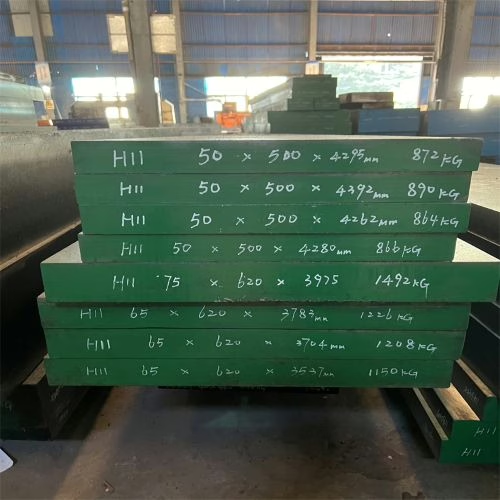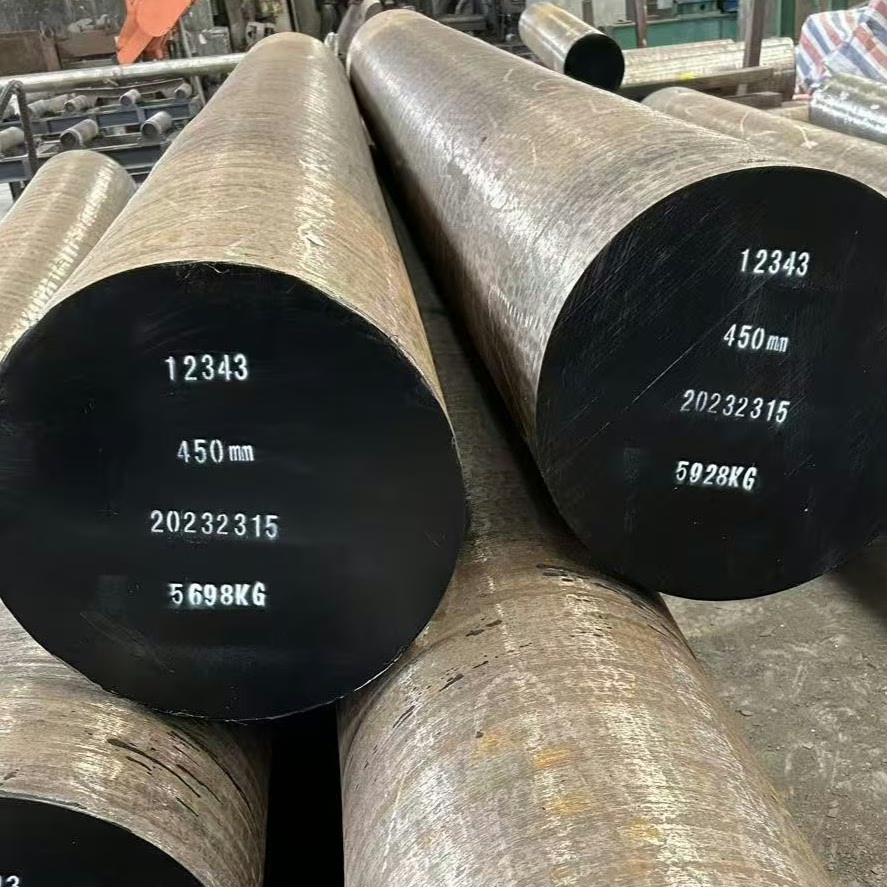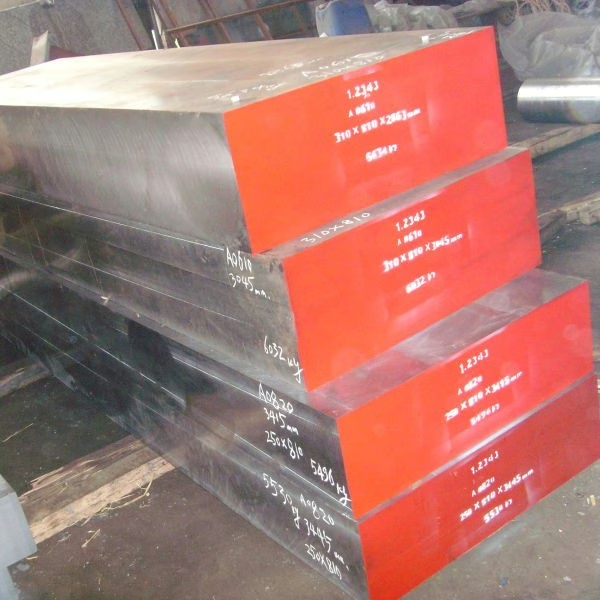Nástrojová ocel H11 je kalená vzduchem nástrojová ocel pro práci za tepla. It has excellent toughness, thermal strength, fatigue performance, and wear resistance at medium temperatures. Additionally, it retains some toughness in the quenched state and demonstrates strong resistance to thermal fatigue. When air-quenched at lower austenitizing temperatures, it exhibits minimal heat treatment deformation and a low tendency to form oxide skin. H11 tool steel can effectively resist the corrosion of molten aluminum, making it a popular choice for manufacturing aluminum die casting molds, hot extrusion tools, stamping and forging molds, and plastic molds.
The designation for this steel is H11 in the U.S. ASTM A681 system. Similarly, other national standards use comparable designations, such as ISO X37CrMoV5-1, Japan/JIS SKD6, USA/UNS T20811, Germany/DIN X38CrMoV5-1, Germany/W-Nr. 1.2343, Czech Republic (CSN) 19552, and China/GB 4Cr5MoSiV.
1. Aplikace
- Licí formy
- Kovací matrice
- Extruzní nástroje
- Žhavé nůžky:
- Letecké a kosmické komponenty
2. Chemické složení1
| C | Mn | Si | Cr | Mo | PROTI |
| 0,33 – 0,43% | 0,20 – 0,60% | 0,80 – 1,25% | 4,75 – 5,50% | 1,10 – 1,60% | 0,30 – 0,60% |
H11 tool steel equivalent grades and the compositions
| Známky | C | Si | Mn | P | S | Cr | Mo | PROTI |
| DIN 1.2343 | 0.33 – 0.43% | 0.80 – 1.25% | 0.20 – 0.60% | ≤ 0.030% | ≤ 0.030% | 4.75 – 5.50% | 1.10 – 1.60% | 0.30 – 0.60% |
| JIS SKD6 | 0.32 – 0.42% | 0.80 – 1.20% | 0.20 – 0.50% | ≤ 0.030% | ≤ 0.030% | 4.50 – 5.50% | 1.00 – 1.50% | 0.30 – 0.60% |
| GB 4Cr5MoSiV | 0.33 – 0.43% | 0.80 – 1.20% | 0.20 – 0.50% | ≤ 0.030% | ≤ 0.030% | 4.75 – 5.50% | 1.10 – 1.60% | 0.30 – 0.60% |
3. Vlastnosti2
Nástrojová ocel H11 má výjimečnou kombinaci dosažitelné tvrdosti, tvrdosti za tepla (červené), houževnatosti a odolnosti proti opotřebení.
- PevnostLze jej tepelně zpracovat na mez kluzu 0,2%, která je výrazně vyšší než 1380 MPa (200 ksi) a mez pevnosti v tahu přesahující 2070 MPa (300 ksi).
- TvrdostNormální pracovní tvrdost se obvykle pohybuje v rozmezí 40 až 55 HRC. Pro aplikace, jako je tlakové lití hliníku, se uvádí preferovaná tvrdost 47 HRC. Při tlakovém lití lze kalit formy H11 na 42–52 HRC, vložky a jádra na 46–52 HRC, písty na 46–50 HRC, saně na 46–52 HRC, pouzdra pro vstřikování na 44–48 HRC a trysky na 32–42 HRC. Pro razníky a matrice pro kování za tepla se tvrdost obvykle pohybuje v rozmezí 44–48 HRC. Válce pro válcování za tepla (pro krátké série a nízké teploty) používají H11 s tvrdostí 40–48 HRC. Formy pro kování za tepla mají obvykle tvrdost 48–52 HRC.
- Tvrdost za horka/tvrdost za červeného náboje: Dobrá odolnost proti popouštění, zachování vysoké tvrdosti a pevnosti při zvýšených teplotách. Odolává měknutí při trvalém vystavení teplotám až do 540 °C (1000 °F). I když je její tvrdost za tepla nižší než u některých jiných ocelí pro práci za tepla, jako jsou H19 nebo H21, stále si zachovává tvrdost lépe než jiné středně legované oceli i při vyšších teplotách. Tvrdost za tepla/červená tvrdost je velmi důležitou vlastností nástrojových ocelí pro práci za tepla.
- Houževnatost a tažnost: Dobrá tažnost a rázová houževnatost. Má lepší odolnost proti křehkému lomu ve srovnání s ocelemi s vyšším obsahem legovaných kovů, jako jsou H14, H19 a H21. Procesy elektrostruskového přetavování (ESR) nebo vakuového obloukového přetavování (VAR) mohou výrazně zlepšit tažnost a houževnatost.
- Odolnost proti únavěTento materiál dokáže poskytovat vysokou úroveň odolnosti proti únavě a tepelné stability v teplotním rozsahu 75 až 540 °C (167 až 1000 °F). Ve srovnání s ocelí 4340, která prošla stejným vysoce intenzivním tepelným zpracováním, má H11 lepší únavovou pevnost.
- Odolnost proti opotřebeníJeho odolnost proti opotřebení je nižší než u H13.
- Svařitelnost: It is readily weldable, even in heavy sections.
- Obrobitelnost: Good machinability, rated around 70% of a standard 1% carbon steel.
- Tepelné vlastnostiMá relativně nízký koeficient tepelné roztažnosti a tepelnou vodivost 26 W/m·K.
- Odolnost proti koroziNadprůměrná odolnost vůči oxidaci a korozi.
- Odolnost proti tepelnému testováníDobrá odolnost vůči tepelné únavě nebo tepelnému namáhání.

Interested in H11 tool steel? Vyplňte níže uvedený formulář a kontaktujte nás hned teď!
4. Tepelné zpracování nástrojové oceli H11
Přesný H11 tool steel heat treatment je klíčový pro dosažení optimálního výkonu jako chromové zápustkové oceli 5% pro práci za tepla a ultravysokopevnostní oceli, podobné modifikované oceli H11 a H13. Tento proces vylaďuje mikrostrukturu pro náročné tovární nástroje.
4.1 Kování
Tato ocel se snadno kuje s vhodným rozsahem kovacích teplot 1120 až 1150 °C (2050 až 2100 °F)Doporučujeme předehřátí polotovaru na 790 až 815 °C (1450 až 1500 °F), a poté rovnoměrně zahřejte na kovací teplotu. Kovací teplota musí NE být nižší než 925 °C (1700 °F)Pokud teplota klesne blízko této úrovně, musí být před pokračováním v kování znovu ohřátá.
4.2 Austenitizace (kalení)
Austenitizace, primární krok kalení, zahrnuje zahřívání, jehož cílem je transformovat jeho strukturu na austenitTo umožňuje rovnoměrnou přeměnu a rozpouštění legujících prvků a karbidů.
- Předehřívání: Předehřev H11 na 760–815 °C (1400–1500 °F) před austenitizací se doporučuje k minimalizaci tepelného šoku a praskání, zejména u tohoto vysoce legovaného materiálu.
- Austenitizační teploty a doby namáčení: Austenitizační teplota je 995 až 1025 °C (1825 až 1875 °F). Doba namáčení je 20 minut + 5 minut na každých 25 mm (1 palec) tloušťky.
Udržování na austenitizační teplotě zajišťuje rovnoměrnou transformaci a rozpouštění.
4.3 Quenching
Po austenitizaci se ocel H11 rychle kalí za vzniku tvrdého martenzitu. H11 je ocel kalitelná na vzduchu, která zajišťuje rovnoměrné kalení ve velkých průřezech s minimálním zbytkovým napětím a změnou rozměrů. Chlazení vzduchem je standardní a preferovanou metodou pro nástrojovou ocel H11. Zatímco chlazení vzduchem je standardní, kalení v oleji od 995 °C (1825 °F) je možnou alternativou. H11 a další nástrojové oceli pro práci za tepla musí nikdy nebýt uhašen vodou, protože to může vést k praskání.
4.4 Temperování
After hardening, tempering H11 tool steel by reheating to a lower temperature is crucial for improving toughness, relieving stress, and stabilizing properties. Steel H11 is a secondary hardening steel. It achieves its best performance when tempered at temperatures above 510°C (950°F). We recommend performing multiple tempering treatments on it to achieve optimal toughness and extend tool life. Allow parts to cool to room temperature between each tempering cycle to minimize residual austenite.
Table of Hardness and Tempering Temperature for H11 Steel
| Teplota temperování | Rockwell C |
| As quenched | 56 |
| 700°F/370°C | 54 |
| 800°F/425°C | 55 |
| 900°F/480°C | 57 |
| 1000°F/540°C | 56 |
| 1100°F/595°C | 46 |
| 1200°F/650°C | 36 |
4.5 Žíhání
The annealing temperature is 845–900 °C (1550–1650 °F)). Rychlost chlazení je 22–40 °C/h (40–75 °F/h)Tvrdost po žíhání je 192–229 HB.
4.6 Další důležité aspekty tepelného zpracování H11
- Normalizace: Tento proces je obecně nedoporučuje se pro nástrojové oceli H11 nebo H13 z důvodu vysokého rizika praskání, zejména při povrchovém oduhličení.
- Úleva od stresu: Po zpracování oceli H11, jako je broušení, svařování nebo EDM (elektroerozivní obrábění), důrazně doporučujeme podstoupit úpravu pro uvolnění pnutí při teplotě 650 °C. Tato úprava by měla být provedena při teplotě o 14–28 °C (25–50 °F) nižší, než je předchozí teplota popouštění. Po uvolnění pnutí pomalu ochlazujte maximální rychlostí 300 °C/h, aby se zabránilo vzniku nových pnutí.
- Kryogenní léčba: Sub-zero treatment (e.g., -73°C / -100°F) can reduce retained austenite, but H11’s high tempering temperatures usually make it unnecessary for achieving maximum secondary hardening response.
- Ochrana povrchu: Ochrana jeho povrchů před oxidací a oduhličením během vysokoteplotního zpracování, jako je austenitizace a žíhání, je zásadní. Toho se často dosahuje pomocí řízené atmosféry, vakuových pecí nebo solných lázní.
5. Supply forms and dimensions
The H11 tool steel we supply is available in various forms, including round bars, sheet plates, slabs, flat bars, square bars, and blocks. The dimensions of the flat bar range from: width 20–600 mm × thickness 20–400 mm × length 1,000–5,500 mm. The dimensions of the round bar range from a diameter of 20–400 mm × a length of 1,000–5,500 mm. The block dimensions are obtained by cutting the flat bar.
For smaller sizes, such as round bars with a diameter less than 70 mm, we use the hot-rolled process. For sizes greater than 70 mm, we offer forged products.
UT testing: Sep 1921-84 D/d, E/e.
Surface Treatment: original black, peeled, machined/turned, polished, grounded, or milled surface finishes.
Inventory Status: We do not maintain a stock of H11 tool steel. We arrange production based on customer orders.
Delivery time: Electric Arc Furnace (EAF) materials are 30-45 days. ESR materials are approximately 60 days.



- Bringas, J. E. (Ed.). (2004). Příručka srovnávacích světových ocelářských norem (3rd ed., p. 434). ASTM International. ↩︎
- Murray, G. T. (Ed.). (1997). Příručka pro výběr materiálů pro inženýrské aplikace. CRC Press. ↩︎
FAQ
H11 steel is primarily an air-cooling type hot work mold steel, often referred to as DIN 1.2343 or JIS SKD6. It is a chromium-based hot work tool steel highly valued for its exceptional toughness and ability to retain its properties even at elevated temperatures. It is used extensively in the manufacturing of molds.
H11 tool steel is noted for its excellent impact toughness, strong resistance to thermal fatigue (also known as heat checking), and high strength, maintaining these qualities at temperatures approaching 600°C. It also offers good wear resistance, hardenability, plasticity, corrosion resistance, high temperature stability, oxidation resistance, and weldability, making it relatively easy to process.
H11 steel is recognized globally under various designations, including DIN 1.2343 (Germany), JIS SKD6 (Japan), and BH11 (British Standard). In the USA, it aligns with standards like ASTM A681, FED QQ-T-570, SAE J437, SAE J438, SAE J467, and its Unified Numbering System (UNS) designation is T20811.
H11 steel contains less vanadium than H13 steel. This results in H11 having higher toughness and superior resistance to thermal fatigue cracking (better handling of repeated heating and cooling cycles) compared to H13, though it might have slightly less wear and temper resistance.
H11 steel is often chosen when the application demands maximum resistance to cracking and thermal shock, particularly when water cooling is involved in service or under frequent heating and cooling cycles. Its superior toughness and generally easier machinability (due to lower hardness) also make it a favorable choice over H13 for certain projects.
H11 tool steel is frequently used in hot tooling applications that require high resistance to cracking. Key applications include die casting dies (especially for aluminum and magnesium alloys), forging dies, hot punches, hot shear blades, and extrusion tooling. It is also utilized in the aerospace industry for critical structural components, such as aircraft landing gear.
Yes, H11 steel is widely used in the manufacturing of plastic molds, particularly for the insert parts of the mold.
H11 tool steel is commonly available as round bars, sheets, plates, and flat bars. It can also be supplied as slabs, billets, wire, shapes, steel coils, and pipes. Surface conditions vary, including original black, peeled, polished, machined, hot rolled, ground, turned, drawn, or cold rolled.
For hardening, H11 tool steels are generally preheated to 816°C (1500°F) and then directly heated to 1010°C (1850°F), where they are held at that temperature for 15 to 40 minutes. The hardening process is completed by air-quenching, which is effective due to H11’s very high hardenability. Some methods involve oil cooling after quenching from 1000 °C to 1030°C, followed by air cooling.
Tempering of H11 steel is performed at temperatures ranging from 538 to 649°C (1000 to 1200°F) to achieve a Rockwell C hardness between 54 and 38. Double tempering is highly recommended, with each tempering step lasting one hour at the chosen temperature, followed by air cooling.
Yes, H11 tool steels can be welded using conventional methods. However, special procedures are often necessary, including pre-heating and using filler materials that match the base material’s composition. It’s important to note that H11 is susceptible to hydrogen-induced cracking (HIC) due to its high alloy content and hardenability, so precise temperature control (e.g., 310-370°C for hardfacing) during welding is crucial.
Yes, H11 steel exhibits good machinability. Its machinability rate is approximately 75% to 80% compared to 1% carbon steel and about 75% of “W” group tool steels. It is often considered easier to machine than H13 steel because of its lower hardness.
H11 tool steels are typically forged at around 1121°C (2050°F). Forging below 899°C (1650°F) is not recommended. The precise temperature can vary, generally falling within a range of 1000 to 1200°C (1832 to 2192°F), depending on desired deformation properties.
Yes, H11 steel serves as an excellent substrate for PVD coating. For nitriding, a small diffusion zone is preferred, and the formation of compound and oxidized layers should be avoided. H11 is suitable for bath, gas, and plasma nitriding processes and can be nitrided at temperatures of 500-600°C to achieve a hard surface. Studies have also explored TiN coatings on H11 steel.
The hardness of H11 steel post-heat treatment varies with tempering. For general applications, a hardness of 50-54 HRC is common. When air-cooled from 1038°C (1900°F) for 45 minutes, it can reach up to 57 HRC. Tempering within the range of 538-649°C (1000-1200°F) can result in a Rockwell C hardness from 54 down to 38.
Yes, H11 tool steel (specifically DIN 1.2343 / AISI H11) can be produced through additive manufacturing processes, such as Laser Powder Bed Fusion (LPBF). Research indicates that subsequent heat treatments after LPBF can be used to precisely tailor the microstructure and hardness of these additively manufactured steels.
Ocel H11 má obvykle stupeň obrobitelnosti 60-70% ve srovnání s nástrojovou ocelí W1 kalitelnou ve vodě (která slouží jako referenční hodnota obrobitelnosti nástrojových ocelí 100%).
Potřebujete vysoce výkonnou nástrojovou ocel H11?
Get Your Custom Quote from Aobo Steel’s Experts Today!
S přes 20 let zkušeností se specializovaným kováním, Aobo Steel is your trusted source for premium H11 tool steel. We deliver durable, high-performance materials precisely tailored to your application’s demands. Our dedicated specialists are here to provide expert advice and ensure you get the perfect H11 solution.
Jste připraveni vylepšit svůj projekt špičkovou nástrojovou ocelí H11? Jednoduše vyplňte níže uvedený formulář to connect with our team. We’ll provide a personalized quote and answer all your questions.
Prozkoumejte naše další produkty
D2/1.2379/SKD11
D3/1.2080/SKD1
D6/1,2436/SKD2
A2/1.23663/SKD12
O1/1.2510/SKS3
O2/1,2842
S1/1,2550
S7/1,2355
DC53
H13/1.2344/SKD61
H11/1.2343/SKD6
H21/1,2581/SKD7
L6/1.2714/SKT4
M2/1.3343/SKH51
M35/1.3243/SKH55
M42/1.3247/SKH59
P20/1,2311
P20+Ni/1,2738
420/1.2083/2Cr13
422 z nerezové oceli
Ložisková ocel 52100
Nerezová ocel 440C
4140/42CrMo4/SCM440
4340/34CrNiMo6/1,6582
4130
5140/42Cr4/SCR440
SCM415

